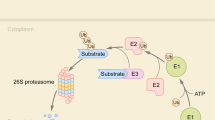Abstract
THE kinase p56lck (Lck) is a T-lymphocyte-specific member of the Src family of non-receptor tyrosine kinases1. Members of the Src family each contain unique amino-terminal regions, followed by Src-homology domains SH3 and SH2, and a tyrosine kinase domain. SH3 and SH2 domains mediate critical protein interactions in many signal-transducing pathways2. They are small, independently folded modules of about 60 and 100 residues, respectively, and they are often but not always found together in the same molecule. Like all nine Src-family kinases (reviewed in ref. 3), Lck is regulated by phosphorylation of a tyrosine in the short C-terminal tail of its catalytic domain4. There is evidence that binding of the phosphorylated tail to the SH2 domain inhibits catalytic activity of the kinase domain5,6 and that the SH3 and SH2 domains may act together to effect this regulation7. Here we report the crystal structures for a fragment of Lck bearing its SH3 and SH2 domains, alone and in complex with a phosphotyrosyl peptide containing the sequence of the Lck C-terminal regulatory tail. The latter complex represents the regulatory apparatus of Lck. The SH3–SH2 fragment forms similar dimers in both crystals, and the tail peptide binds at the intermolecular SH3/SH2 contact. The two structures show how an SH3 domain might recognize a specific target and suggest how dimerization could play a role in regulating Src-family kinases.
This is a preview of subscription content, access via your institution
Access options
Subscribe to this journal
Receive 51 print issues and online access
$199.00 per year
only $3.90 per issue
Buy this article
- Purchase on Springer Link
- Instant access to full article PDF
Prices may be subject to local taxes which are calculated during checkout
Similar content being viewed by others
References
Marth, J. D., Peet, R., Krebs, E. G. & Perlmutter, R.M. Cell 43, 393–404 (1985).
Koch, C. A., Anderson, D., Moran, M. F., Ellis, C. & Pawson, T. Science 252, 668–674 (1991).
Cooper, J. A. & Howell, B. Cell 73, 1051–1054 (1993).
Abraham, N., Miceli, M. C., Parnes, J. R. & Veillette, A. Nature 350, 62–66 (1991).
Cantley, L. C. et al. Cell 84, 281–302 (1991).
Roussel, R. R., Brodeur, S. R., Shalloway, D. & Laudano, A. P. Proc. natn. Acad. Sci. U.S.A. 88, 10696–10700 (1991).
Superti-Furga, G., Fumagalli, S., Koegl, M., Coutneidge, S.A. & Draetta, G. EMBO J. 12, 2625–2634 (1993).
Booker, G. W. et al. Cell 73, 813–822 (1993).
Yu, H. et al. Science 258, 1665–1668 (1992).
Musachio, A., Nobel, M., Pauptit, R., Wierenga, R. & Saraste, M. Nature 359, 851–855 (1992).
Booker, G. W. et al. Nature 358, 684–687 (1992).
Overduin, M., Rios, C. B., Mayer, B. J., Baltimore, D. & Cowburn, D. Cell 70, 697–704 (1992).
Waksman, G. et al. Nature 358, 646–653 (1992).
Eck, M. J., Shoelson, S. E. & Harrison, S.C. Nature 362, 87–91 (1993).
Songyang, Z. et al. Cell 72, 767–778 (1993).
Waksman, G., Shoelson, S. E., Pant, N., Cowburn, D. & Kuriyan, J. Cell 72, 779–790 (1993).
Cicchetti, P., Mayer, B. J., Thiel, G. & Baltimore, D. Science 257, 803–806 (1992).
Prasad, K. V. S. et al. Molec. cell. Biol. 13, 7708–7717 (1993).
Grandori, C. & Hanafusa, H. J. Cell biol 107, 2125–2135 (1988).
Kato, J. Y. et al. Molec. cell. Biol. 6, 4155–4160 (1986).
Potts, W. M., Reynolds, A. B., Lansing, T. J. & Parsons, T. J. Oncogene Res. 3, 343–355 (1988).
Kraulis, P. J. appl. Crystallogr. 24, 946–950 (1991).
Lee, B. K. & Richards, F. M. J. molec. Biol. 55, 379–400 (1971).
Janin, J. & Chothia, C. J. biol. Chem. 265, 16027–16030 (1990).
Piccione, E. et al. Biochemistry 32, 3197–3202 (1993).
Kabsch, W. J. appl. Crystallogr. 21, 916–924 (1988).
Brünger, A. T. X-PLOR, Version 3.0: A System for Crystallography and NMR (Yale Univ., New Haven, 1992).
Navaza, J. AMoRe: A New Package for Molecular Replacement 1-87-90 (SERC, Daresbury, UK, 1992).
Jones, T. A. in Molecular Replacement: Proc. CCP4 Study Weekend (eds Dodson, E. J., Gover, S. & Wolf, W.) 91–105 (SERC, Daresbury, UK, 1992).
Jones, T. A., Bergdoll, M. & Kjeldgaard, M. in Crystallographic Computing and Modeling Methods in Molecular Design (eds Bugg, C. & Earlick, S.) (Springer, New York, 1989).
Author information
Authors and Affiliations
Rights and permissions
About this article
Cite this article
Eck, M., Atwell, S., Shoelson, S. et al. Structure of the regulatory domains of the Src-family tyrosine kinase Lck. Nature 368, 764–769 (1994). https://doi.org/10.1038/368764a0
Received:
Accepted:
Issue Date:
DOI: https://doi.org/10.1038/368764a0
This article is cited by
-
The LCK-14-3-3ζ-TRPM8 axis regulates TRPM8 function/assembly and promotes pancreatic cancer malignancy
Cell Death & Disease (2022)
-
Src family kinases, adaptor proteins and the actin cytoskeleton in epithelial-to-mesenchymal transition
Cell Communication and Signaling (2021)
-
Predictive Model of Lymphocyte-Specific Protein Tyrosine Kinase (LCK) Autoregulation
Cellular and Molecular Bioengineering (2016)
-
Solution structure of the Grb2 SH2 domain complexed with a high-affinity inhibitor
Journal of Biomolecular NMR (2008)
-
A unique set of SH3–SH3 interactions controls IB1 homodimerization
The EMBO Journal (2006)
Comments
By submitting a comment you agree to abide by our Terms and Community Guidelines. If you find something abusive or that does not comply with our terms or guidelines please flag it as inappropriate.



